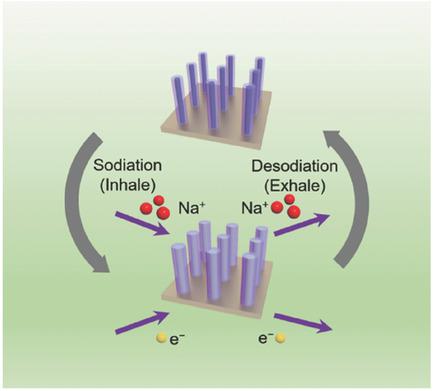当前位置:
X-MOL 学术
›
Adv. Funct. Mater.
›
论文详情
Our official English website, www.x-mol.net, welcomes your
feedback! (Note: you will need to create a separate account there.)
Regulation of Breathing CuO Nanoarray Electrodes for Enhanced Electrochemical Sodium Storage
Advanced Functional Materials ( IF 18.5 ) Pub Date : 2018-02-06 , DOI: 10.1002/adfm.201707179 Jiangfeng Ni 1 , Yu Jiang 1, 2 , Feixiang Wu 3 , Joachim Maier 3 , Yan Yu 3 , Liang Li 1
Advanced Functional Materials ( IF 18.5 ) Pub Date : 2018-02-06 , DOI: 10.1002/adfm.201707179 Jiangfeng Ni 1 , Yu Jiang 1, 2 , Feixiang Wu 3 , Joachim Maier 3 , Yan Yu 3 , Liang Li 1
Affiliation

|
Cupric oxide (CuO) represents an attractive anode material for sodium‐ion batteries owing to its large capacity (674 mAh g−1) associated with multiple electron transfer. However, the substantial volume swelling and shrinking (≈170%) upon Na uptake and release, which mimics an electrode breathing process, disturbs the structural integrity, leading to poor electrochemical durability and low Coulombic efficiency. Here, a structural strategy to regulate the breathing of CuO nanoarray electrodes during Na cycling using an atomic layer deposition of cohesive TiO2 thin films is presented. CuO nanoarrays are electrochemically grown on 3D Cu foam and directly used as anodes for sodium storage. The regulated CuO electrode arrays enable a large reversible capacity (592 mAh g−1), a high cycle efficiency (≈100%), and an excellent cycling stability (82% over 1000 cycles), which are some of the best sodium storage performance values reported for CuO systems. Electrochemical impedance and microscopic examination reveal that the enhanced performance is a direct outcome of the efficient regulation of the breathing of CuO nanowires by TiO2 layer.
中文翻译:

呼吸式CuO纳米阵列电极对增强电化学钠存储的调节
氧化铜(CuO)由于具有大容量(674 mAh g -1)与多次电子转移有关,因此是钠离子电池的一种有吸引力的负极材料。但是,Na吸收和释放时的大量体积膨胀和收缩(≈170%)模仿了电极的呼吸过程,扰乱了结构完整性,导致电化学耐久性差和库仑效率低。在此,提出了一种结构策略,该策略使用粘性TiO 2薄膜的原子层沉积来调节Na循环过程中CuO纳米阵列电极的呼吸。CuO纳米阵列在3D Cu泡沫上电化学生长,并直接用作钠存储的阳极。调节后的CuO电极阵列可实现大可逆容量(592 mAh g -1),高循环效率(≈100%)和出色的循环稳定性(在1000次循环中达到82%),这是CuO系统报道的最佳钠存储性能值。电化学阻抗和显微镜检查表明,增强的性能是TiO 2层有效调节CuO纳米线呼吸的直接结果。
更新日期:2018-02-06
中文翻译:

呼吸式CuO纳米阵列电极对增强电化学钠存储的调节
氧化铜(CuO)由于具有大容量(674 mAh g -1)与多次电子转移有关,因此是钠离子电池的一种有吸引力的负极材料。但是,Na吸收和释放时的大量体积膨胀和收缩(≈170%)模仿了电极的呼吸过程,扰乱了结构完整性,导致电化学耐久性差和库仑效率低。在此,提出了一种结构策略,该策略使用粘性TiO 2薄膜的原子层沉积来调节Na循环过程中CuO纳米阵列电极的呼吸。CuO纳米阵列在3D Cu泡沫上电化学生长,并直接用作钠存储的阳极。调节后的CuO电极阵列可实现大可逆容量(592 mAh g -1),高循环效率(≈100%)和出色的循环稳定性(在1000次循环中达到82%),这是CuO系统报道的最佳钠存储性能值。电化学阻抗和显微镜检查表明,增强的性能是TiO 2层有效调节CuO纳米线呼吸的直接结果。











































 京公网安备 11010802027423号
京公网安备 11010802027423号